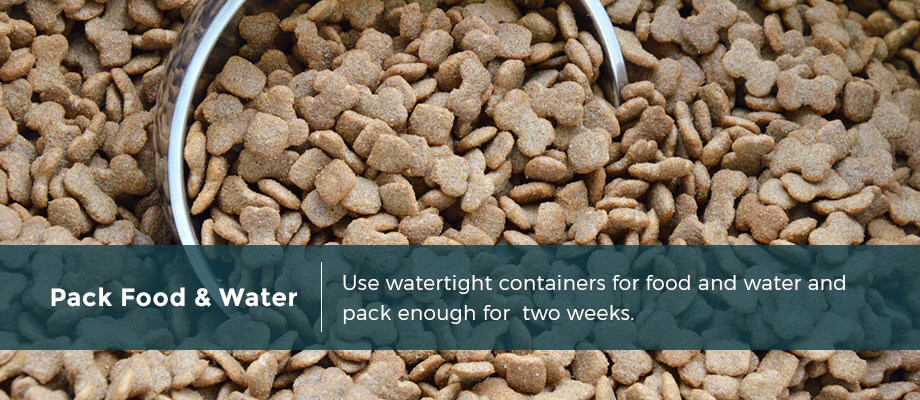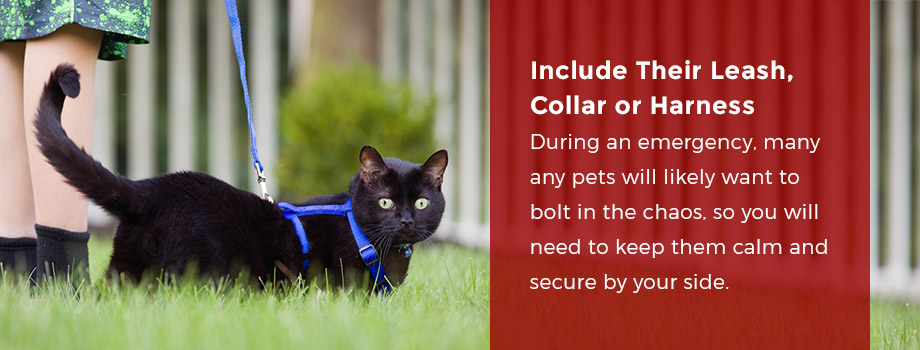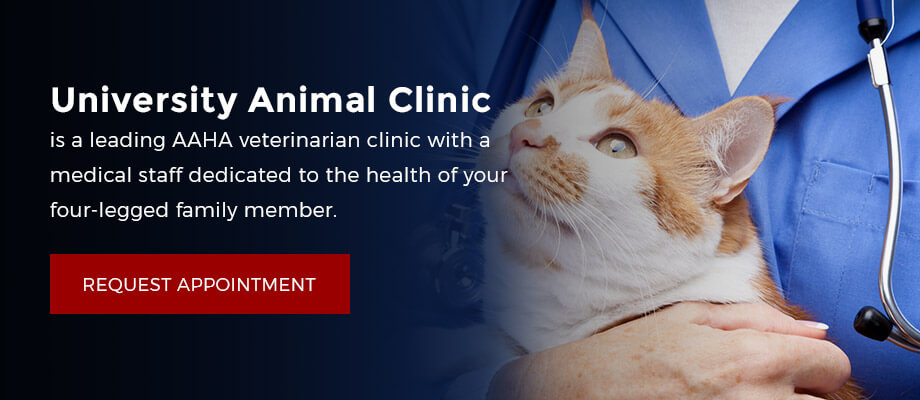
Floods, tornadoes, hurricanes and other crises are scary realities. When these natural disasters threaten your area, people have to leave their homes and seek shelter. Many prepare for these disasters and the possible evacuation, especially if they live on the coast and are at risk for hurricanes or flash floods. But have you considered what you will do with your pet if disaster strikes?
Pets need you to take care of them during natural disasters. They can’t find shelter, stay safe or flee severe storms on their own. Find out what natural disasters can hit your region and prepare for an emergency for your pet’s safety and your own. The following checklist can help you with everything from finding pet-friendly accommodations to packing a pet evacuation bag.

1. Find A Pet-Friendly Shelter
Even if you live in a place that is prone to natural disasters, they can still take you by surprise. As you’re preparing to evacuate, consider your pet’s safety and where you can transport them for shelter. If the weather is dangerous enough to require evacuation, you should never leave your pet behind. If you leave your pet at home during a hurricane or flooding, they can get lost, become trapped, sustain serious injuries or worse. While rescuers do an excellent job of freeing animals after disasters, you can find a place in advance to transport your pet and ensure they stay safe.
No matter how long you expect to be gone, your pet should come with you. Weather is unpredictable and could keep you away from your home for several days. Before you need to evacuate, research possible shelters or boarding options for you and your pet:
- Call Ahead to Find a Pet-Friendly Shelter. Not all shelters allow pets, but certain ones will let you bring along your dog or cat. Call the shelters in your area to find out their policies on animals. Your local veterinarian might also have a list of pet-friendly places that are close by. Your local humane society or emergency resource center should include options for evacuated animals.
- Scout out Hotels. Gather a list of hotels that allow pets outside your immediate location, so you can quickly evacuate with your pet if the time comes. Many hotels offer rooms for an additional fee for pet-owners. In the past, some hotels have waived these fees or relaxed policies to aid evacuees, but that is not always the case, so always make sure to double check and be prepared. Some websites can help you locate accommodations in your region for pets as well.
- Ask Friends and Family. If you have family or friends living outside your area, you might ask to stay with them during the disaster. Ask them if they would consider allowing your dog or cat to stay with them, too. Before severe weather hits, check with relatives or close friends to see if they are comfortable making room for you and your pet.
2. Put A Rescue Alert Sticker On Your House
New laws and regulations have increased resources and relief for animals during disasters. The Pets Evacuation and Transportation Standards (PETS) Act was created to assist service animals and household pets when natural disasters strike. However, many pets are still left in danger.
Luckily, rescuers are often on the scene to find these pets, but it helps them to know if you have a pet in your home and if that animal evacuated with you. Rescue alert stickers can provide this information. The stickers have areas to list the number and kind of animals in your house and an emergency number to contact. If you manage to take your pet with you during an evacuation, you can write “evacuated” on the sticker so that rescuers continue past your place. Place this sticker on your front door or window so rescuers can clearly see it. These are free to pet-owners and only require a request form to obtain one.

3. Pack Food And Water
Disasters may last longer than you think, so it is better to prepare more food and water than your pet will drink rather than not enough. Many situations can prevent you from getting additional supplies, although it is unlikely that you will be away from a store or your home for that long. As you gather together supplies for emergencies, you should pack water, food and bowls for your pet. Use watertight containers for food and water.
You want to keep your pet healthy and strong during the time you are gone, so take a sufficient amount of supplies. Don’t pack enough for just a day or two, even if you think you’ll only be gone for a few hours. Include two weeks worth of food for your animal. Non-perishable food is recommended when preparing an emergency kit. If your pet primarily eats canned wet food, remember to bring a can opener. Collapsible bowls will save you room in the pack and keep it light when you need to grab it and go. Bottled water is easy to store in these kits, too.
4. Bring A Pet Carrier
Most pet-friendly shelters require animals to stay in carriers. One reason for this is that not all animals get along — even within the same species. To avoid conflicts and keep your pet safe, bring them in a carrier to your shelter location. Your animal may need extra things like waste bags, a potty training pad or a litter box as well, so be sure to consider all the items your pet needs to be as comfortable as possible.
In the midst of the disaster, your pet will likely be frightened and tense. Even if you are watching out for your pet, they’ll be in survival mode, so it’s possible they can have abnormal and potentially aggressive behavior. Putting your pet in an enclosed space can protect them, you and other nearby pets or people. A carrier — or a crate for larger dogs and other animals — can help your pet feel safe, too. It provides a place of familiarity while they are under stress.
Keep in mind that it does take time to train your animal to be comfortable in a crate or carrier, and you’ll want them used to being inside one if an emergency happens. You might normally think of doing this more often for dogs, but this is a good idea for cats as well. You can put treats or food on the floor to help them warm up to the carrier or crate. When you close the door, stay nearby for the first few times. Remember to not use the crate as punishment or keep your pet in it for too long.
When a natural disaster occurs, you want your pet to enter the crate without a struggle. If you need to stay at a shelter with your pet or in a pet-friendly hotel room, you can keep your pet in a crate for their safety and your own.

5. Include Their Leash, Collar Or Harness
When you are evacuating your home and going to a shelter, you will need to lead your pet in the right direction. Leashes, collars and harnesses are not only for dogs. They are also available for most kinds of animals in an emergency. Additionally, if you haven’t already, consider microchipping your pet to make sure it is easy to identify your pet in the event that they get disconnected from you during a disaster. Many pets will likely want to bolt in the chaos, so you will need to keep them calm and secure by your side. Crowded shelters and loud, stormy weather will probably cause your pet distress. These items simply help you handle your scared pet with more ease.
If you are boarding your pet or leaving it in the care of your relatives, it is especially important to pack a leash and collar. The collar should include an ID with your contact information. If your pet gets lost during the natural disaster or the evacuation process, you’ll want to ensure they are returned to you as quickly and safely as possible.
You can either store these items in your evacuation kit or hang them by the door for easy access. As you rush to get yourself, your family and your pet out the door and on the road, ensure you can grab these items for your pet as well.
6. Remember Your Pet’s Medications
When you’re packing your evacuation kit, you will probably remember basic necessities for your pet, like food, water and hygiene items. But your pet’s medicine is also crucial. It may be trickier if it is a prescription medicine that you need to refill periodically, but you still want to keep this on your natural disaster checklist.
You can also pack the medicine ahead of time, but remember to cycle it out, so it doesn’t expire. Other health concerns and medicine you can include may help your pet relax or even treat any wounds they might sustain during the disaster. Keep these medical-related items in mind as you’re making your disaster kit checklist:
- Regular Medication. Pets can regularly be prescribed medicine for bacterial infections, worms, parasites, fungal infections in the ears and more. Your pet may also take a pain reliever often due to arthritis, or they may be taking one for a short time because of recent surgery. Pets also have allergies to food, environmental substances and fleas, and prescriptions to fight these symptoms or alleviate pain might be a part of your pet’s routine. Take these along, so your pet’s health does not suffer during the crisis. Bring preventatives like flea, tick and heartworm medicine along, too.
- Relaxant. Because natural disasters are stressful for pets, they can be nervous. Giving your pet the appropriate medication can calm their nerves and help with their anxious behavior. Benadryl is one medicine that is safe to give to animals and can cause them to become sleepy. Another support for nervous pets is an anxiety wrap. This works for some cats and dogs during stormy conditions and potentially during natural disasters.
- Pet First Aid Kit. Like any emergency kit, be sure to have first aid items for your pet. This precaution benefits you and your pet in emergencies. You can fill your pet’s first aid kit with gauze, adhesive tape, antibiotic cream, antiseptics, bandages, wound cleaning products, petroleum jelly and a thermometer, or you can purchase one made especially for animals. If you include hydrogen peroxide in the kit to induce vomiting, you should only use it for this purpose if your veterinarian instructs you to.
Another thing to keep in mind is the possibility of diseases, for both you and your pet. Your pet may encounter something in their new environment, either through contact with other animals in a shelter, in nature if they escape or from contaminated water. Be sure to wash your hands after being in contact with your pet, and if possible, keep your pet from licking you because some diseases to be transferred from pets to humans.

7. Pack The Necessary Documentation For Your Pet
For identification purposes and medical emergencies, keep important documents and records on hand. You can make copies of your pet’s records to put in your evacuation pack and backup digital copies for your phone or a USB drive. Many practices, including University Animal Clinic, have a free app which allows you to access your pet’s medical records and vaccine history at any time. Written proof of vaccinations and prescriptions are vital, especially in case you need to see a different veterinarian. Your admittance into a pet-friendly shelter might depend on proof of core vaccinations, too. If your pet has serious medical issues or surgeries, then your records will come in handy.
If you can’t manage to find your pet’s records, contact your veterinarian to request copies of the files. You can pack recent pictures of your pet or pre-made lost posters as well in case you are separated during the evacuation. Your pet’s registration information is also essential if they get lost. Put your contact information in and on your evacuation pack, too, in case it is misplaced and contains these valuable documents.

Find More Natural Disaster Resources For Your Pet
As you consider how to best protect your animal during natural disasters, start packing an emergency kit for your pet. If you are a resident of Florida, hurricanes, tropical storms, tornadoes and floods may hit your home. Make sure your pet has accommodations, a caretaker and supplies if inclement weather affects your area. For additional resources and information, ask your local veterinarian clinic for tips on getting your pets to safety.
University Animal Clinic is a leading AAHA accredited veterinarian clinic with a medical staff dedicated to the health of your four-legged family member. Along with the highest of medical quality, we also want to educate you about natural disaster preparation for your pets.
For your pet’s health needs, we offer wellness plans for companion animals and exotics. Our passion for preventative care can keep your beloved animal happy and healthy. Contact us today to request an appointment or find out about natural disaster resources in our area.
